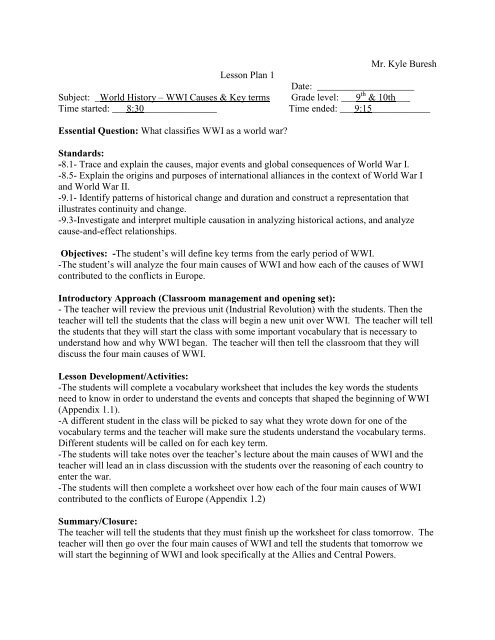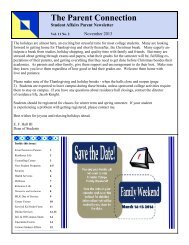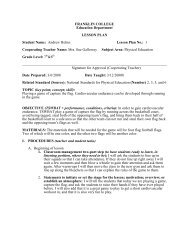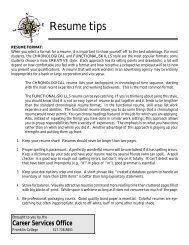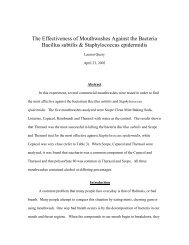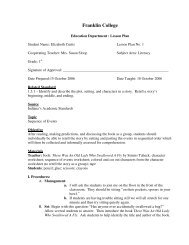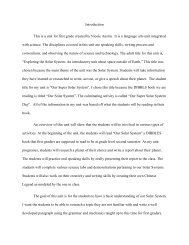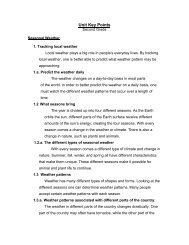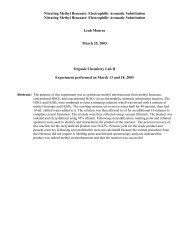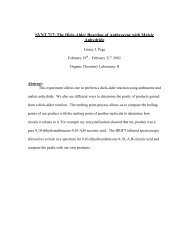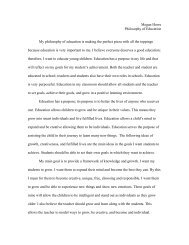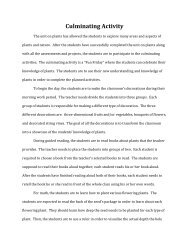Lesson Plan - Franklin College
Lesson Plan - Franklin College
Lesson Plan - Franklin College
You also want an ePaper? Increase the reach of your titles
YUMPU automatically turns print PDFs into web optimized ePapers that Google loves.
Mr. Kyle Buresh<br />
<strong>Lesson</strong> <strong>Plan</strong> 1<br />
Subject: _World History – WWI Causes & Key terms<br />
Date: ____________________<br />
Grade level: ___9 th & 10th___<br />
Time started: ___8:30_______________ Time ended: ___9:15____________<br />
Essential Question: What classifies WWI as a world war?<br />
Standards:<br />
-8.1- Trace and explain the causes, major events and global consequences of World War I.<br />
-8.5- Explain the origins and purposes of international alliances in the context of World War I<br />
and World War II.<br />
-9.1- Identify patterns of historical change and duration and construct a representation that<br />
illustrates continuity and change.<br />
-9.3-Investigate and interpret multiple causation in analyzing historical actions, and analyze<br />
cause-and-effect relationships.<br />
Objectives: -The student’s will define key terms from the early period of WWI.<br />
-The student’s will analyze the four main causes of WWI and how each of the causes of WWI<br />
contributed to the conflicts in Europe.<br />
Introductory Approach (Classroom management and opening set):<br />
- The teacher will review the previous unit (Industrial Revolution) with the students. Then the<br />
teacher will tell the students that the class will begin a new unit over WWI. The teacher will tell<br />
the students that they will start the class with some important vocabulary that is necessary to<br />
understand how and why WWI began. The teacher will then tell the classroom that they will<br />
discuss the four main causes of WWI.<br />
<strong>Lesson</strong> Development/Activities:<br />
-The students will complete a vocabulary worksheet that includes the key words the students<br />
need to know in order to understand the events and concepts that shaped the beginning of WWI<br />
(Appendix 1.1).<br />
-A different student in the class will be picked to say what they wrote down for one of the<br />
vocabulary terms and the teacher will make sure the students understand the vocabulary terms.<br />
Different students will be called on for each key term.<br />
-The students will take notes over the teacher’s lecture about the main causes of WWI and the<br />
teacher will lead an in class discussion with the students over the reasoning of each country to<br />
enter the war.<br />
-The students will then complete a worksheet over how each of the four main causes of WWI<br />
contributed to the conflicts of Europe (Appendix 1.2)<br />
Summary/Closure:<br />
The teacher will tell the students that they must finish up the worksheet for class tomorrow. The<br />
teacher will then go over the four main causes of WWI and tell the students that tomorrow we<br />
will start the beginning of WWI and look specifically at the Allies and Central Powers.
Description of meeting the needs of multiple learning styles:<br />
-Intrapersonal- Independent writing of the vocabulary terms and comprehension of what they<br />
read and write by themselves<br />
-Interpersonal- Students had to discuss the vocabulary words and were called on the say the<br />
definition out loud in the classroom. Also, students discussed the causes of WWI and each<br />
country’s reason for becoming involved in the war with the teacher and other students.<br />
-Linguistic- Students will read vocabulary words and write down the definitions on a worksheet.<br />
Modifications for students with special needs:<br />
-Students with special needs will have to write the word instead of the definition when students<br />
do the worksheet of key terms. It is their sheltered vocabulary list.<br />
Formative Assessment:<br />
-Vocabulary worksheet focusing on the key terms of the buildup to WWI and the main<br />
causes for the war.<br />
-Worksheet that has the students describe how each underlying cause of the war<br />
contributed to the conflicts in Europe.
Appendix 1.1 Name: ___________________<br />
Alliance-<br />
Nationalism-<br />
Militarism-<br />
Imperialism-<br />
Triple Alliance-<br />
Triple Entente-<br />
Road to WWI Vocabulary 10 pts possible<br />
Archduke Francis Ferdinand-
Appendix 1.2 ROOTS OF THE WAR<br />
DIRECTIONS: Complete the chart below filling in each section to describe how<br />
each underlying cause of the war contributed to the conflicts in Europe.<br />
12 pts possible<br />
nationalism<br />
imperialism<br />
militarism<br />
military<br />
alliances
Mr. Kyle Buresh<br />
<strong>Lesson</strong> <strong>Plan</strong> 2<br />
Date: ____________________<br />
Subject: _World History – WWI Powers and Early battles Grade level: ___9 th & 10 th ___<br />
Time started: ____8:30_________________ Time ended: _____9:15_______<br />
Essential Question: What classifies WWI as a world war?<br />
Standards:<br />
-8.1- Trace and explain the causes, major events and global consequences of World War I.<br />
-8.5- Explain the origins and purposes of international alliances in the context of World War I<br />
and World War II.<br />
-9.1- Identify patterns of historical change and duration and construct a representation that<br />
illustrates continuity and change.<br />
-9.2-Locate and analyze primary sources and secondary sources related to an event or issue of<br />
the past.<br />
Objectives: -The students will analyze a map which separates the Allied and Central Powers.<br />
-The students will identify which country was associated with which power and which countries<br />
were neutral.<br />
-Students will evaluate the early battles of WWI, the differences of war on the Eastern and<br />
Western front, and trench warfare.<br />
Introductory Approach (Classroom management and opening set):<br />
-Bell Ringer- The students will write down the four main causes of WWI and the two alliances<br />
that were in place. The teacher will then tell the students they will be talking about the Central &<br />
Allied powers, the early battles of WWI, and the different types of war on the Western front and<br />
Eastern front.<br />
<strong>Lesson</strong> Development/Activities: -The students will have a map activity that asks them questions<br />
about the Central powers, Allied powers, and Neutral countries (Appendix 2.1).<br />
-The students will keep their handouts out while they take notes on a PowerPoint explaining the<br />
Central powers, Allied powers, and Neutral countries. The PowerPoint will also cover the early<br />
battles of WWI, the differences between war on the Western and Eastern front, and the<br />
importance of trench warfare.<br />
-The students will complete another map worksheet that will help them review the information<br />
from today’s lesson (Appendix 2.2).<br />
Summary/Closure:<br />
-The teacher will explain to the students that they must hand in the map worksheet about the<br />
early battles of the war at the beginning of class tomorrow. After the lesson, the teacher will<br />
give the students a question to think about, ―What classifies WWI a world war?‖ The teacher<br />
will then tell the students that tomorrow we will be doing stations around the room learning<br />
about the weaponry and new technology that came about in WWI.
Description of meeting the needs of multiple learning styles:<br />
-Visual- The student’s will see maps of Europe at the beginning of the war in 1914 and see what<br />
countries are Allied, Central, or Neutral in WWI. The students will also see various visuals on<br />
the PowerPoint slides.<br />
-Intrapersonal- The students will complete worksheets on their own by reading and coming up<br />
with their own answers to the questions.<br />
-Linguistic- The students will have to read and write their answers while the worksheet and talk<br />
when asked by the teacher during the lecture.<br />
Modifications for students with special needs:<br />
-Students with special needs will receive slides from the PowerPoint and have them to write<br />
notes next to the slide were on so they can have the slides and their notes to further help them. I<br />
will also assist them with the worksheets.<br />
Formative Assessment: -Map worksheet over the Central powers, Allied Powers, and Neutrals.-<br />
Map worksheet and questions over early battles, East/Western front differences, and trench<br />
warfare.
Appendix 2.1 Allied & Central Powers 10 pts possible<br />
1) Who were the Allied powers?<br />
2) Who were the Central powers?<br />
3) What countries remained neutral?<br />
4) What advantage did the Allied powers have in their positioning being between some of<br />
the Central powers (Germany, Austria-Hungary)
Appendix 2.2 WWI Early Wars 10 pts possible<br />
1) Which countries did the Central powers offensive move to?<br />
2) Which countries did the Allied powers offenses move to?<br />
3) What is H.G. Wells saying about new war technology when he says, ―Now, there does<br />
not appear the slightest hope of any invention that will make war more conclusive or less<br />
destructive; there is, however, the clearest prospect in many directions that it may be<br />
more destructive and less conclusive. It will be dreadfuller and bitterer: its horrors will<br />
be less and less forgivable.‖<br />
-H.G. Wells, ―Civilization at the Breaking Point,‖ New York Times, May 27, 1915<br />
4) In a paragraph, explain what trench warfare is and why they were used in the war?<br />
5) In a paragraph, explain the differences between war on the Western Front and war on the<br />
Eastern front?
Mr. Kyle Buresh<br />
<strong>Lesson</strong> <strong>Plan</strong> 3<br />
Date: ____________________<br />
Subject: _World History- WWI – Weapons & Technology Grade level: ___9 th & 10th___<br />
Time started: ___8:30__________________ Time ended: ____9:15___________<br />
Essential Question: What classifies WWI as a world war?<br />
Standards:<br />
-8.1- Trace and explain the causes, major events and global consequences of World War I.<br />
-8.5- Explain the origins and purposes of international alliances in the context of World War I<br />
and World War II.<br />
Objectives: -The students will examine different types of weaponry used during WWI.<br />
-The students will identify the new technology that changed the tactics of war.<br />
Introductory Approach (Classroom management and opening set):<br />
- The teacher will give the students a bell ringer from the question asked at the end of the<br />
previous day, ―What allows WWI to be classified as a world war?‖ The students will write their<br />
answers on paper and put it in their class binders. The teacher will tell the students that we will<br />
be doing stations around the room examining different forms of weapons and technologies that<br />
were used during WWI and how they impacted the war so much.<br />
<strong>Lesson</strong> Development/Activities:<br />
-The teacher will split the students up into groups of four that will rotate from a pod of four<br />
desks to the next pod of four desks and so on. The groups will determined by numbering<br />
students while in their original desks. The students will take notes individually but discuss each<br />
weapon or piece of technology together. Information will come from http://www.greatwindmill.com/WWI.php.<br />
-Each station will contain photographs of each weapon or piece of technology and have a<br />
description of that weapon and other facts (Appendix 3.1)<br />
-The teacher will tell the students to write down three interesting facts about each weapon or<br />
piece of technology; (What countries used it? When it was invented? Another interesting fact).<br />
-The teacher will tell the students to rotate counterclockwise and they will have four minutes at<br />
each station before he/she tells them to move to the next station to take notes.<br />
Summary/Closure: -The teacher will tell the students to go back to their seats after the last<br />
stations time is up. The teacher will ask the students which weapon or piece of technology<br />
interested them the most and why. The teacher will have the students provide responses aloud.<br />
The teacher will then talk about what made some of these weapons and technologies so<br />
interesting for the time they were invented and used. Lastly, the teacher will tell the students that<br />
tomorrow they will be looking at the American entrance into WWI.
Description of meeting the needs of multiple learning styles:<br />
-Interpersonal- The students have to work in groups to get the facts they need for their notes.<br />
Students will have to communicate with one another.<br />
-Linguistic- Students will have to read the information about each weapon or piece of technology<br />
and determine what is important for them to write down in their notes.<br />
-Visual- Students will look at the weapons and piece of technology at each station they take<br />
notes on in order for them to see what it looks like.<br />
-Kinesthetic- Students will move around the room from one station to another.<br />
Modifications for students with special needs:<br />
-The teacher will pair up a student with special needs with one who is successful in the<br />
classroom so they can help that person. The teacher will be walking around the stations during<br />
the class period as well so he/she can help anyone who needs any assistance at all.<br />
Formative Assessment: -Students notes that will be checked in their binders once every week.<br />
-Teacher observation during the group stations.
Mr. Kyle Buresh<br />
<strong>Lesson</strong> <strong>Plan</strong> 4<br />
Date: ____________________<br />
Subject: _World History – A World War-U.S. Entrance Grade level: ___9 th & 10th___<br />
Time started: ___8:30_______________ Time ended: ___9:15____________<br />
Essential Question: What classifies WWI as a world war?<br />
Standards:<br />
-8.1- Trace and explain the causes, major events and global consequences of World War I.<br />
-8.5- Explain the origins and purposes of international alliances in the context of World War I<br />
and World War II.<br />
Objectives: -The students will analyze a primary document.<br />
-The students will evaluate Wilson’s decision to enter WWI.<br />
-The students will reproduce what they have learned by taking a quiz.<br />
Introductory Approach (Classroom management and opening set):<br />
-The teacher will begin the class asking a few brief questions about the weapons and technology<br />
that the students took notes on the previous lesson. The teacher will then tell the classroom that<br />
they will be looking at the decision of Wilson to enter WWI.<br />
<strong>Lesson</strong> Development/Activities:<br />
- The students will answer two questions after they analyze a primary source from their textbook<br />
of a picture of a book cover about the sinking of the Lusitania on page 766. The students will<br />
read a short summary about the sinking of the Lusitania before they answer the questions.<br />
-The students will then read an article from an internet source about the reasons that the U.S.<br />
entered the war and write down all the different causes on their own pieces of paper (Appendix<br />
4.1). The students will put their answers in their notebook to use as notes.<br />
-The students will then take a quiz over the material that they have learned up to this point over<br />
WWI (Appendix 4.2).<br />
Summary/Closure:<br />
The teacher will recap the day’s lesson before the students take the quiz. The teacher will<br />
explain that the importance of the reasons that the U.S. joined the war and stress the decision that<br />
Wilson made. The students will then end the class by taking a quiz over the material they have<br />
previously learned about WWI. The students will turn in their finished quizzes before the end of<br />
class.<br />
Description of meeting the needs of multiple learning styles:<br />
-Linguistic- The students will study a primary document and interpret its meaning. The students<br />
will read an online article about the reasons the U.S. entered the war.<br />
-Visual- The students will study a picture from the primary document and interpret it.<br />
-Intrapersonal- The students will write down the main reasons that the U.S. entered the war<br />
individually.
Modifications for students with special needs:<br />
The students with special needs will be able to use their vocabulary and key terms list for their<br />
quiz.<br />
Formative Assessment:<br />
-The students will answer two questions over a primary document from page 766 in the<br />
textbook. The students will keep their answers in their classroom binders<br />
-The students will write down the main causes for the U.S. entering into WWI and keep them in<br />
their binders.<br />
-The students will take a quiz over the material they have previously learned about WWI.
Appendix 4.1 U.S. Entrance into WWI<br />
This entry is a subentry of World War I (1914 – 18).<br />
Like the origins of World War I itself, the causes of U.S. entry on 6 April 1917 have been<br />
much debated. The 1930s emphasis on economic motivations—the desire of American<br />
munitions makers and financers to protect their stake in the Allied victory—has been<br />
superseded by two new interpretations. One, a broad view enunciated first by historians<br />
William Appleman Williams and N. Gordon Levin, emphasizes the desire of President<br />
Woodrow Wilson and many among America's economic and foreign policy elites to ensure<br />
a liberal, capitalist world order in contrast to reactionary militarism and colonialism or<br />
widespread revolution and communism. The other reflects a greater focus on Wilson's<br />
decision making and is put forward by Arthur S. Link, Ernest May, Robert H. Ferrell, and<br />
Thomas J. Knock. They emphasize variously the strategic situation of the United States as<br />
the leading neutral industrial and financial power; and the influence upon Wilson of the<br />
German submarine warfare, the predominantly pro‐British attitude of American elites, and<br />
the president's own appropriation of the leadership of the liberal movement toward a just<br />
and lasting peace based upon a league of nations.<br />
In 1914, Wilson proclaimed U.S. neutrality in keeping with American tradition. He was also<br />
aware of the great divisions over the war: although perhaps a bare majority of Americans<br />
favored Britain, nearly as many were hostile to the Allies because of ethnic loyalties or<br />
suspicions of Britain, the world's most powerful empire and financial center, or hostility<br />
toward czarist Russia with its autocracy and pogroms.<br />
Both Germany and Britain violated U.S. neutral maritime rights, as Wilson strictly defined<br />
them, but German submarine warfare seemed more ruthless, particularly with the sinking of<br />
the Lusitania, a British passenger liner, in 1915. American trade with the Allies tripled to $3<br />
billion a year between 1914 and 1916 and helped economic recovery in the United States.<br />
Pro‐British elites and the urban press increasingly emphasized German immorality—the<br />
invasion of neutral Belgium and alleged atrocities there and later the barbarity of sub marine<br />
warfare. Seeking to avoid being drawn into the war but also insisting on Americans' right to<br />
aid the Allies, Wilson held Germany to ―strict accountability‖ for its submarine warfare, and<br />
for a while caused Berlin to restrict its U‐boats.<br />
After his reelection in 1916, Wilson offered to mediate a peace; but both sides refused.<br />
Berlin then decided on unrestricted submarine warfare, beginning 1 February 1917, to starve<br />
Britain into terms. Wilson severed diplomatic relations on 3 February. American public<br />
opinion was also inflamed by the Zimmermann note, in which Germany sought a military
alliance with Mexico against the United States. When submarines sank three American<br />
merchant ships, Wilson abandoned temporary armed neutrality and decided to take the<br />
United States into the war, in part because his strict accountability policy had failed and in<br />
part because he wanted the United States to help shape a treaty for peace.<br />
In his powerful war message of 2 April 1917, Wilson condemned the German submarine<br />
campaign as ―warfare against mankind,‖ and urged Americans to fight, in his famous<br />
phrase, to make the world ―safe for democracy.‖ By a vote of 82–6 in the Senate (4 April)<br />
and 373–50 in the House (6 April), Congress adopted a resolution declaring that a state of<br />
war existed between the United States and Germany.<br />
[See also Germany, U.S. Military Involvement in.]<br />
Bibliography<br />
William Appleman Williams, The Tragedy of American Diplomacy, 1959.<br />
Ernest R. May, The World War and American Isolation, 1914–1917, 1959.<br />
Arthur S. Link, Wilson: Campaigns for Progressivism and Peace, 1916–1917, 1965.<br />
N. Gordon Levin, Jr., Woodrow Wilson and World Politics: America's Response to War<br />
and Revolution, 1968.<br />
Ross Gregory, The Origins of American Intervention in the First World War, 1971.<br />
Robert H. Ferrell, Woodrow Wilson and World War I, 1917–1921, 1985.<br />
Thomas J. Knock, To End All Wars: Woodrow Wilson and the Quest for a New World<br />
Order, 1992<br />
http://www.answers.com/topic/world-war-i-1914-18-causes-of-u-s-entry
Appendix 4.2 Name:________________________<br />
WWI-Quiz<br />
Circle the letter of the correct answer on each question. Each question will be worth 2 points.<br />
The quiz is out of 20 points.<br />
1. Which countries formed the Triple Entente?<br />
a. France, U.S.A., Great Britain<br />
b. France, Russia, Italy<br />
c. France, Great Britain, and Russia<br />
2. Which countries formed the Triple Alliance?<br />
a. Italy, Austria-Hungary, France<br />
b. Italy, Austria-Hungary, Germany<br />
c. Italy, Russia, U.S.A.,<br />
3. People were proud of their countries and prepared to fight to defend them. This is called:<br />
a. Imperialism<br />
b. Nationalism<br />
c. Militarism<br />
4. Early on in the war, the western front battles primarily consisted of……<br />
a. mobile battles<br />
b. trench warfare<br />
c. battles on the water<br />
5. War on the eastern front was extremely different than on the western front as it consisted<br />
primarily of….<br />
a. mobile battles<br />
b. trench warfare<br />
c. battles on the water<br />
6. This form of weapon caused blisters, blindness, choked and killed its victims. It was first<br />
used by the German forces.<br />
a. tanks<br />
b. gas<br />
c. machine guns<br />
7. These weapons were used during WWI.<br />
a. machine guns<br />
b. nuclear bombs<br />
c. airplanes<br />
8. The German sinking of this British ship led to the U.S. entering the war.<br />
a. USS Ulysses<br />
b. Lusitania<br />
c. a British submarine<br />
9. Another reason the U.S. entered the war was because of a diplomatic proposal from the<br />
German empire to Mexico to make war against the U.S.<br />
a. Wilson’s 14 Points<br />
b. Zimmerman Telegram<br />
c. Lusitania<br />
10. In two sentences explain what classifies WWI as a world war?
Mr. Kyle Buresh<br />
<strong>Lesson</strong> <strong>Plan</strong> 5<br />
Date: ____________________<br />
Subject: _World History – WWI Society & End of War Grade level: ___9 th & 10th___<br />
Time started: ___8:30_______________ Time ended: ___9:15____________<br />
Essential Question: What classifies WWI as a world war?<br />
Standards:<br />
-8.1- Trace and explain the causes, major events and global consequences of World War I.<br />
-8.5- Explain the origins and purposes of international alliances in the context of World War I<br />
and World War II.<br />
Objectives: -The students will analyze public opinion, total war, and women during WWI.<br />
- The students will list the reasons for the end of the war.<br />
Introductory Approach (Classroom management and opening set):<br />
The students will be handed back their graded quizzes from the previous day. The teacher will<br />
go over the quiz and explain the answers to the class. The teacher will then tell the students that<br />
they will be looking at society during WWI.<br />
<strong>Lesson</strong> Development/Activities:<br />
-The students will answer two questions over the influenza epidemic in 1918 from the textbook<br />
(page 768). The students will complete a short reading then answer the questions and put their<br />
answers in their classroom binders.<br />
-The students will read page 768-769 over manipulation of public opinion, total war, and<br />
women. Once the students are done reading they will team up with the person next to them to<br />
take notes over the most important facts and concepts that they read about.<br />
-The teacher will go over these notes with the students so they have all the important information<br />
that they should have.<br />
-The students will then read page 778-780. When the students finish the reading they will pair<br />
up with the person behind them and take notes over the main facts and concepts from what they<br />
have read.<br />
-The teacher will go over the student’s notes with them so they have all the important<br />
information they need.<br />
Summary/Closure:<br />
The teacher will go over the main points talked about during the class period. The teacher will<br />
ask the students if there are any questions and if so the teacher will answer them. The teacher<br />
will then tell the students that tomorrow they will continue to look at the end of the war moving<br />
into the aftermath of the war and what the legacies of the war were.<br />
Description of meeting the needs of multiple learning styles:<br />
-For the students with ADHD I will shorten the reading for them so they will be able to maintain<br />
their focus. I will also give the students with special needs a sheltered vocabulary list of words<br />
from the reading.
Modifications for students with special needs:<br />
-Interpersonal- The students will take notes with a partner. The students will discuss their notes<br />
with the teacher.<br />
-Intrapersonal- The students will read by themselves.<br />
-Linguistic- The students will read and take notes.<br />
Formative Assessment:<br />
-The students will answer two questions from their textbook (page 768) about the influenza<br />
epidemic of 1918<br />
-The students will take notes that will be put in their classroom binders. The teacher will look at<br />
the binders at the end of each week.
Mr. Kyle Buresh<br />
<strong>Lesson</strong> <strong>Plan</strong> 6<br />
Subject: _World History – Legacies of the War<br />
Date: ____________________<br />
Grade level: ___9 th & 10th___<br />
Time started: ___8:30_______________ Time ended: ___9:15____________<br />
Essential Question: What classifies WWI as a world war?<br />
Standards:<br />
-8.1- Trace and explain the causes, major events and global consequences of World War I.<br />
-8.5- Explain the origins and purposes of international alliances in the context of World War I<br />
and World War II.<br />
-9.1- Identify patterns of historical change and duration and construct a representation that<br />
illustrates continuity and change.<br />
-9.2- Locate and analyze primary sources and secondary sources related to an event or issue of<br />
the past.<br />
Objectives: -The students will interpret a graph of statistics related to WWI.<br />
-The students will list and analyze the peace settlements resulting of the war.<br />
-The students will examine the legacies of the war that affected the world after the war.<br />
Introductory Approach (Classroom management and opening set):<br />
-The students will pick up a worksheet from the first desk in the room when they get into the<br />
classroom to start on immediately. The teacher will then interrupt the students working on their<br />
worksheet and ask what were the reasons for the end of the war, which they learned about in the<br />
previous lesson. After the students answer the question, the teacher will tell the students that<br />
today they will be learning about the effects of WWI statistically, the peace settlements, and the<br />
legacies of the war.<br />
<strong>Lesson</strong> Development/Activities:<br />
-The students will complete a worksheet about the statistics related to the war (Appendix 6.1).<br />
The students will analyze a chart of statistics and answer questions about the worksheet. The<br />
teacher will go over the worksheet with the students in class.<br />
-The students will then watch a short video from YouTube about the Treaty of Versailles.<br />
http://www.answers.com/topic/world-war-i-1914-18-causes-of-u-s-entry<br />
-The students will take notes in groups by doing stations over the peace settlements including:<br />
Wilson’s Fourteen Points, The Paris Peace Conference, and the Treaty of Versailles. The<br />
students will also take notes over the legacies of the war. The students will take notes by being<br />
split up into groups of four. The desks will be in pods of four and the students will rotate around<br />
the room from one station to another in order to get all the notes and learn about all of the<br />
important facts and concepts. (Appendix 6.2).<br />
-The teacher will discuss the notes with the students to make sure they have all the important<br />
facts and concepts that they need to have in their notes.<br />
-For homework, the students will complete a two paragraph writing prompt that asks the students<br />
what makes WWI a world war after looking at the peace settlements and legacy of the war?
Summary/Closure:<br />
-The teacher will go over the important facts from the day’s lesson. The teacher will ask various<br />
questions to get the students involved in the summary. The teacher will then explain how<br />
significant the legacies of the war were toward the future. The teacher will then tell the students<br />
that tomorrow they will be doing a project over the whole unit so far.<br />
Description of meeting the needs of multiple learning styles:<br />
-Interpersonal- The students will work with other students to take notes.<br />
-Intrapersonal- The students will complete a worksheet over important statistics of WWI by<br />
themselves<br />
-Linguistic- The students will have to read and write at numerous times during the lesson and<br />
for homework.<br />
-Visual- The students will watch a video over the Treaty of Versailles.<br />
-Kinesthetic- The students will move around the room while doing stations for notes.<br />
Modifications for students with special needs:<br />
-For students with special needs I will give the students a sheltered vocabulary list for the<br />
reading they are doing. The students will also be given a sheltered vocabulary list for the<br />
worksheets they are doing.<br />
Formative Assessment:<br />
-The students will complete a worksheet over statistics related to WWI (Appendix 6.1).<br />
-The students will take notes during their stations that they will put in their classroom binders,<br />
which will be checked at the end of every week.<br />
-The students will complete a writing prompt for homework that asks them what makes WWI a<br />
world war in terms of the peace settlements and legacies of the war in two paragraphs.
Appendix 6.1<br />
Statistics related to the First World War<br />
Nation Total Number<br />
of servicemen<br />
engaged in the<br />
war.<br />
Number of<br />
deaths.<br />
Number of<br />
soldiers<br />
wounded.<br />
Number of men<br />
taken prisoner<br />
or reported<br />
missing.<br />
Austria 7,800,000 1,200,000 3,620,000 2,200,000<br />
Britain (inc<br />
Empire)<br />
8,904,467 908,371 2,090,212 191,652<br />
France 8,410,000 1,357,800 4,266,000 537,000<br />
Germany 11,000,000 1,773,700 4,216,058 1,152,800<br />
Italy 5,615,000 650,000 947,000 600,000<br />
Russia 12,000,000 1,700,000 4,950,000 2,500,000<br />
Turkey 2,850,000 325,000 400,000 250,000<br />
United States 4,355,000 126,000 234,300 4,500<br />
Answer the following questions: 10 possible points<br />
1. Which country had the most soldiers in World War One?<br />
2. Which country had the least soldiers in World War One?<br />
3. Which country had the highest number of deaths?<br />
4. Which country had the least number of deaths<br />
5. Draw a graph on the back of your paper to show the numbers of soldiers of each country<br />
and the numbers of deaths.<br />
12,000,000<br />
10,000,000<br />
8,000,000<br />
6,000,000<br />
4,000,000<br />
2,000,000<br />
0<br />
2002 www.historyonthenet.co.uk<br />
Number of Soldiers Number of Deaths<br />
Austria<br />
Britain<br />
France<br />
Germany<br />
Italy<br />
Russia<br />
Turkey<br />
USA<br />
Example
Appendix 6.2<br />
Woodrow Wilson, The Fourteen Points (1918)<br />
Part of an 1918 address to Congress, Wilsonís Fourteen Points were fourteen aims he hoped<br />
would result from World War I. Clearly one goal of the points was to address many of the<br />
factors that promoted the beginning of the World War in Europe and to establish a basis for a<br />
more peaceful world; in this sense Wilson hoped World War I would be a "war to end all war."<br />
Many of the other points concern territorial adjustments based on the principle of national selfdetermination.<br />
The fourteenth point called for the creation of a League of Nations. As you read,<br />
think about how one might view Wilsonís goals for World War I as progressive.<br />
I. Open covenants of peace, openly arrived at, after which there shall be no private international<br />
understandings of any kind... diplomacy shall proceed always frankly and in the public view.<br />
II. Absolute freedom of navigation upon the seas... alike in peace and war....<br />
III. The removal... of all economic barriers and the establishment of an equality of trade<br />
conditions among all the nations.<br />
IV. Adequate guarantees... that national armaments will be reduced to the lowest point<br />
consistent with domestic safety.<br />
V. A free, open-minded, and absolutely impartial adjustment of all colonial claims, based upon a<br />
strict observance of the principle that in determining all such questions of sovereignty the<br />
interests of the populations concerned must have equal weight with the equitable claims of the<br />
government whose title is to be determined....<br />
VI. The evacuation of all Russian territory and such a settlement of all question affecting Russia<br />
as will secure the best and freest cooperation of the other nations of the world in obtaining for<br />
her an... opportunity for the independent determination of her own political development....<br />
VII. Belgium... must be evacuated and restored, without any attempt to limit the sovereignty<br />
which she enjoys....<br />
VIII. All French territory should be freed and the invaded portions restored, and the wrong done<br />
to France by Prussia [Germany] in 1871 in the matter of Alsace-Lorraine, which has unsettled<br />
the peace of the world for nearly fifty years, should be righted....<br />
IX. A readjustment of the frontiers of Italy... along clearly recognizable lines of nationality.<br />
X. The peoples of Austria-Hungary, whose place among the nations we wish to see safeguarded<br />
and assured, should be accorded the freest opportunity of autonomous development.
XI. Rumania, Serbia and Montenegro should be evacuated; occupied territory restored... the<br />
relations of the several Balkan states to one another determined by friendly consul along<br />
historically established lines of allegiance and nationality; and international guarantees of the<br />
political and economic independence and territorial integrity of the several Balkan states....<br />
XII. The Turkish portions of the Ottoman Empire should be assured a secure sovereignty, but the<br />
other nationalities which are now under Turkish rule should be assured an undoubted security of<br />
life and an absolutely unmolested opportunity of autonomous development....<br />
XIII. An independent Polish state should be erected which should include the territories<br />
inhabited by indisputably Polish populations... whose political and economic independence and<br />
territorial integrity should be guaranteed....<br />
XIV. A general association of nations must be formed under specific covenant for the purpose of<br />
affording mutual guarantees of political independence and territorial integrity to great and small<br />
states alike.<br />
http://www.pinzler.com/ushistory/fourpointssupp.html
Paris Peace Conference<br />
When the Armistice was signed on 11th November, 1918, it was<br />
agreed that there would be a Peace Conference held in Paris to<br />
discuss the post-war world. Opened on 12th January 1919,<br />
meetings were held at various locations in and around Paris until<br />
20th January, 1920.<br />
Leaders of 32 states representing about 75% of the world's<br />
population, attended. However, negotiations were dominated by<br />
the five major powers responsible for defeating the Central<br />
Powers: the United States, Britain, France, Italy and Japan.<br />
Important figures in these negotiations included Georges<br />
Clemenceau (France) David Lloyd George (Britain), Vittorio<br />
Orlando (Italy), and Woodrow Wilson (United States).<br />
Eventually five treaties emerged from the Conference that dealt<br />
with the defeated powers. The five treaties were named after the<br />
Paris suburbs of Versailles (Germany), St Germain (Austria),<br />
Trianon (Hungary), Neuilly (Bulgaria) and Serves (Turkey).<br />
These treaties imposed territorial losses, financial liabilities and<br />
military restrictions on all members of the Central Powers.<br />
http://www.spartacus.schoolnet.co.uk/FWWparis.htm
TREATY OF VERSAILLES<br />
Eventually five treaties emerged from the Conference that dealt with the defeated powers. The<br />
five treaties were named after the Paris suburbs of Versailles (Germany), St Germain (Austria),<br />
Trianon (Hungary), Neuilly (Bulgaria) and Serves (Turkey).<br />
The main terms of the Versailles Treaty were:<br />
The surrender of all German colonies overseas as League of Nations mandates;<br />
The return of Alsace-Lorraine to France;<br />
Cession of Eupen-Malmedy to Belgium, Memel to Lithuania, the Hultschin district to<br />
Czechoslovakia;<br />
Most of the province of Posen, and also most of West Prussia to Poland;<br />
A part of industrial Upper Silesia to Poland;<br />
A plebiscite to be held in another part of Upper Silesia to decide whether it should<br />
become a part of Poland, stay with Germany or be split between the two countries:<br />
Danzig to become a free city;<br />
Plebiscite to be held in Northern Schleswig to settle the Danish-German frontier;<br />
occupation of and special status for the Saar under French control;<br />
Demilitarization and a fifteen-year occupation of the Rhineland;<br />
An acceptance of Germany's guilt in causing the war;<br />
German reparations of £6,600 million;<br />
A ban on the union of Germany and Austria;<br />
Provision for the trial of the former Kaiser and about 885 others for war crimes;<br />
Limitation of Germany's army to 100,000 men with no conscription, no tanks, no heavy<br />
artillery, no poison-gas supplies, no aircraft and no airships;<br />
The limitation of the German Navy to vessels under 10,000 tons, with no submarines.<br />
Germany was invited to comment but not allowed to negotiate the treaty at all and signed under<br />
protest. Whenever they tried to query any detail they were told that they had started the war and<br />
had no right to complain about anything in the treaty.<br />
This Treaty was designed to make Germany pay for the war that it had allegedly started. Another<br />
aim was to weaken Germany.<br />
All German overseas possessions were over handed to the allies as League of Nations Mandates,<br />
the primary benefactors being the British and French, although the Japanese were allowed to<br />
keep several islands they had taken from Germany in the Pacific. Second, the Rhineland was<br />
demilitarized, and Germany was forbidden to have troops there. In fact, Germany was forbidden<br />
from rearming itself beyond defensive purposes.<br />
Alsace-Lorraine was returned to France; large tracts of Western Prussia and the province of<br />
Posen were restored to the newly created Poland; East Prussia was separated rest of Germany by<br />
what came to be known as the Polish Corridor. Germany was also forced to pay exorbitant<br />
reparations to Britain, France, Belgium, the US and Japan. The Treaty did also established a<br />
League of Nations to mediate international conflicts and enforce international law, but the<br />
Europeans had little desire for mediation and America just wanted to get out of European affairs.<br />
www.spartacus.schoolnet.co.uk/FWWversailles.htm
Legacies of WWI<br />
1) German and Russian empires lost a lot of their territory<br />
2) New nation-states were born including Poland, Finland , Estonia, and Latvia<br />
emerged.<br />
3) The Ottoman Empire was broken up.<br />
4) Europe faced problems with new countries, socially, and ethnically among<br />
the people.<br />
5) Germans have a great deal of resentment<br />
German attitudes<br />
Although all Germans were determined to see a revision of the treaty eventually, and to return to<br />
something like the frontiers of 1913, it would be a mistake to imagine that the Treaty of<br />
Versailles was the direct cause of World War II.<br />
By 1925 the way was certainly open for a peaceful renegotiation of the peace settlement, but<br />
Adolf Hitler - who by this time was exploiting the economic, social and political crises of the<br />
Weimar Republic on his way to becoming chancellor in January 1933 - had an insatiable desire<br />
for conquest that could not be saved by such means.<br />
This offered a golden opportunity for Germany to make a second bid for European domination.<br />
His fury, at first, was directed against the democratic parties in the Reichstag - whom he called<br />
the 'November criminals', and whom he regarded as having stabbed Germany in the back when<br />
they accepted the humiliating terms of the Peace of Versailles - rather than towards Lloyd<br />
George and Clemenceau, who were the principal architects of the settlement.<br />
Hitler constantly harped on the theme that the Weimar Republic was born of a self-inflicted<br />
defeat, and thus had no legitimacy. His ferocious attacks on the Treaty of Versailles, one of the<br />
most effective of his ideological weapons, were thus directed against the Republic that he was<br />
determined to destroy.<br />
The principal weakness of the Treaty of Versailles was that it was harsh enough to incense all<br />
Germans, while Germany was in a stronger position than in 1913, since it was now surrounded<br />
by weak and divided states and the Ententes of 1914 had fallen apart. This offered a golden<br />
opportunity for Germany to make a second bid for European domination.<br />
http://www.bbc.co.uk/history/worldwars/wwone/war_end_01.shtml
Mr. Kyle Buresh<br />
<strong>Lesson</strong> <strong>Plan</strong> 7<br />
Subject: _World History –WWI Collage<br />
Date: ____________________<br />
Grade level: ___9 th & 10th___<br />
Time started: ___8:30_______________ Time ended: ___9:15____________<br />
Essential Question: What classifies WWI as a world war?<br />
Standards:<br />
-8.1- Trace and explain the causes, major events and global consequences of World War I.<br />
-8.5- Explain the origins and purposes of international alliances in the context of World War I<br />
and World War II.<br />
-9.1- Identify patterns of historical change and duration and construct a representation that<br />
illustrates continuity and change.<br />
Objectives: -The students will recall previous knowledge over the entire WWI unit.<br />
-The students will create a collage over the most important topics from WWI.<br />
Introductory Approach (Classroom management and opening set):<br />
-The teacher will collect the students writing prompts at the beginning of the class. The teacher<br />
will then go on to explain some of the reasons that the students could have wrote about for what<br />
classifies WWI as a world war in terms of the peace settlements and legacies of the war. The<br />
teacher will ask the students what they wrote about and why. The teacher will then tell the<br />
students that they will be doing a collage over WWI.<br />
<strong>Lesson</strong> Development/Activities:<br />
-The teacher will pass out the WWI collage handout directions to every student in the classroom<br />
(Appendix 7.1). The teacher will read the handout with the students so they all can be clear with<br />
what to do.<br />
-The teacher will then show the students examples of the project and ask the students if they<br />
have any questions about what to do.<br />
-The students will begin working on the collage and will have two class periods to complete the<br />
collage.<br />
-If the students complete their collage in class and there is still time left in the class period they<br />
should begin studying for their quiz that will cover the content from after the last quiz they took.<br />
Summary/Closure:<br />
-The teacher will ask the students if they have any further questions about their collage. The<br />
teacher will tell the students that they will continue to work on their collages tomorrow in class<br />
and will be due the day after tomorrow. If they do not finish tomorrow they will have to take it<br />
home to finish it because it will be due.<br />
Description of meeting the needs of multiple learning styles:<br />
-Visual-Spatial- The students will be drawing on paper to make their collage.<br />
-Intrapersonal- The students will complete the collage on their own and show their creativity.<br />
-Linguistic- The students will use the key words/topics to complete their collage.
Modifications for students with special needs:<br />
-The students who have special needs will not have to have all of the topics on their collage.<br />
They will only have to have nationalism, alliances, the Zimmerman Telegram, machine guns or<br />
tanks, and airplanes on their collage.<br />
Formative Assessment:<br />
-The students will complete a collage over the main topics in WWI.<br />
-The student’s effort will be observed by the teacher in the classroom.
Appendix 7.1<br />
WWI Collage<br />
This assignment is designed to illustrate the many parts of WWI. It is intended to be a collage.<br />
Therefore, there should be no organization or structure to it. The images and pictures can be<br />
organized randomly and haphazardly. Everything listed below needs to be included on the<br />
collage to receive the full credit of 30 points. Here is what NEEDS to be included:<br />
1. Imperialism<br />
2. Nationalism<br />
3. Militarism<br />
4. Alliances<br />
5. Sinking of the Lusitania<br />
6. Zimmerman Telegram<br />
7. U Boats<br />
8. Trench Warfare<br />
9. Airplanes<br />
10. Machine guns OR tanks (you may do both if you want to)<br />
You also need to include the outlines of Europe and North and South America—(especially<br />
taking the Zimmerman Telegram into consideration). I have examples that you may look at to get<br />
ideas if you are confused. I need to see that you have spent time and effort on your collage. The<br />
collage needs to be completely colored (The entire page).<br />
Hint: The pictures DO NOT necessarily have to be people. For example, with alliances, one way<br />
to portray this would be having two hands shaking with the sleeves reading ―Austria-Hungary<br />
and Germany‖ or the ―U.S. and Great Britain.‖ Nationalism could be shown by drawing one of<br />
the countries flag’s with a heart around it.<br />
Points out of 30<br />
-Completion----------5 pts<br />
-Creativity----------5 pts<br />
-Met requirements of everything-----------10 pts<br />
that needs to be portrayed on collage<br />
-Colored------------10 pts<br />
Total-------30 pts
Mr. Kyle Buresh<br />
<strong>Lesson</strong> <strong>Plan</strong> 8<br />
Date: ____________________<br />
Subject: _World History –Review and Test over WWI Grade level: ___9 th & 10th___<br />
Time started: ___8:30_______________ Time ended: ___9:15____________<br />
Essential Question: What classifies WWI as a world war?<br />
Standards:<br />
-8.1- Trace and explain the causes, major events and global consequences of World War I.<br />
-8.5- Explain the origins and purposes of international alliances in the context of World War I<br />
and World War II.<br />
-9.1- Identify patterns of historical change and duration and construct a representation that<br />
illustrates continuity and change.<br />
Objectives: -The students will recall what they have learned while studying for their test and<br />
taking their test.<br />
-The students will evaluate why WWI is considered a world war for the essay on their quiz.<br />
Introductory Approach (Classroom management and opening set):<br />
-The teacher will collect the student’s collages over WWI. The teacher will then tell the students<br />
that they will be taking their final quiz over WWI but will have a little time to study.<br />
<strong>Lesson</strong> Development/Activities:<br />
-The teacher will tell the student to take out their classroom binders to study for their quiz over<br />
society during the war, end of the war, the peace settlements, and legacies of the war. The<br />
teacher will give the students ten minutes to study.<br />
-After ten minutes the teacher will ask the students if they have any questions about anything and<br />
the teacher will answer the questions the students ask.<br />
-The teacher will then pass out the quiz and give the students their instructions.<br />
-The students will complete their tests and hand them when they finish. They will have at least a<br />
half hour to complete the quiz (Appendix 8.1).<br />
Summary/Closure:<br />
-Some students will be finishing up their quiz, but the teacher will talk to them with about a<br />
minute or two left in class about their collages that they turned in that day and tell them that<br />
tomorrow we will start our Risk game that relates to WWI.<br />
Description of meeting the needs of multiple learning styles:<br />
-Intrapersonal- The students will study by themselves at the beginning of the period<br />
-Linguistic- The students will read and write during their quiz.<br />
Modifications for students with special needs:<br />
-Students with special needs will be given a modified test that takes away one of the choices<br />
from the multiple choice question. Also, for their essay they will only have to list two reasons<br />
for why WWI is considered a world war.<br />
Formative Assessment:<br />
-The students will be taking a quiz over society during the war, end of the war, peace<br />
settlements, and legacies of the war (Appendix 8.1)
Appendix 8.1<br />
WWI Quiz 2<br />
Students should circle the letter of the correct answer. The quiz will be out of 30 points. The<br />
first ten questions will be two points each and the final question will be worth ten points.<br />
1. In the fall of 1918, just as WWI was winding down in Europe, a deadly____________ killed<br />
and effected many different people.<br />
a. black plague<br />
b. influenza epidemic<br />
c. cancer<br />
2. ___________ took over jobs for men that were involved in the war.<br />
a. children<br />
b. students<br />
c. women<br />
3. German general who led German troops during the Second Battle of the Marne and Second<br />
Battle of the Somme.<br />
a. Clemenceau<br />
b. Ludendorf<br />
c. Ebert<br />
4. The new government in Germany, a democratic republic signed an_____________ November<br />
11, 1918.<br />
a. Wilson’s 14 Points<br />
b. Treaty of Versailles<br />
c. armistice<br />
5. Wilson’s Fourteen Points outlined goals for how the world should be after the war. Which of<br />
these are goals of his Fourteen Points?<br />
a. make the world more peaceful<br />
b. stipulations of territorial adjustments<br />
c. establish a League of Nations<br />
d. all of the above<br />
6. These countries were all involved in the Paris Peace Conference EXCEPT_____________.<br />
a. U.S.A<br />
b. Germany<br />
c. Great Britain<br />
d. Italy
7. Which of these are terms from the Treaty of Versailles?<br />
a. The surrender of all German colonies overseas as League of Nations mandates<br />
b. The entire war was blamed on Germany<br />
c. a and b<br />
d. The German army was able to reorganize<br />
8. This empire was broken up as a result of WWI.<br />
a. Roman Empire<br />
b. Ottoman Empire<br />
c. Russian Empire<br />
9. Which of these were considered legacies of the war?<br />
a. Germany and Russia lost a lot of their territory<br />
b. New nation-states emerged including Poland, Finland, Estonia, and Latvia<br />
c. Germans have a great deal of resentment<br />
d. all of the above<br />
10. Why does WWI classify as a world war in regards to the peace settlements and legacies of<br />
the war? Write in sentence form and include at least three reasons and write in the space below.<br />
10 pts possible


